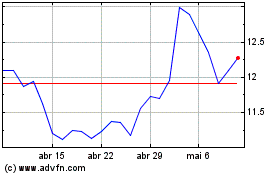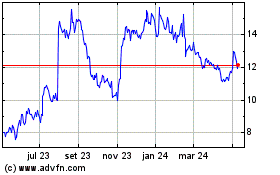Upwork Study Finds Employee Workloads Rising Despite Increased C-Suite Investment in Artificial Intelligence
23 Julho 2024 - 10:00AM

Upwork Inc. (Nasdaq: UPWK), the world’s work marketplace that
connects businesses with independent talent, today released a new
study from The Upwork Research Institute revealing that AI is
increasing the workloads of full-time employees, hampering
productivity, and contributing to employee burnout.
While business leaders are investing heavily in AI, the study
shows that most organizations are currently failing to unlock the
full productivity value of the technology. Despite 96% of C-suite
leaders expressing high expectations that AI will enhance
productivity, 77% of employees using AI say these tools have added
to their workload, and nearly half (47%) of employees using AI
report they do not know how to achieve the expected productivity
gains.
“Our research shows that introducing new technologies into
outdated work models and systems is failing to unlock the full
expected productivity value of AI,” said Kelly Monahan, managing
director of The Upwork Research Institute. “While it's certainly
possible for AI to simultaneously boost productivity and improve
employee well-being, this outcome will require a fundamental shift
in how we organize talent and work.”
Key findings from the
report include:
- Workers are
feeling the strain from rising
productivity demands, with 1 in 3 full-time employees
saying they will likely quit their jobs in the next six
months: 81% of global C-suite leaders acknowledge they
have increased demands on their workers in the past year.
Consequently, 71% of full-time employees are burned out, and 65%
report struggling with their employer’s demands on their
productivity. Alarmingly, 1 in 3 employees say they will likely
quit their jobs in the next six months due to burnout or being
overworked.
- C-suite leaders have high hopes that AI will help boost
productivity, but employees are experiencing the opposite, with AI
making their jobs harder: 96% of C-suite leaders expect
the use of AI tools to increase their company’s overall
productivity levels. Already, 85% of companies are using AI,
including 39% mandating the use of AI tools and 46% encouraging
their use. However, 77% of employees report that these tools have
added to their workload. Employees report spending more time
reviewing or moderating AI-generated content (39%), investing more
time learning how to use these tools (23%), and being asked to do
more work as a direct result of AI (21%).
- For many workers, the path to achieving the
productivity gains that employers expect is not clear:
Nearly half (47%) of employees using AI say they have no idea how
to achieve the productivity gains their employers expect, and 40%
feel their company is asking too much of them when it comes to
AI.
- Freelancers unlock productivity with AI, outpacing
full-time employees: Nearly half (48%) of freelancers say
they’re “somewhat” or “highly” skilled at using AI, and over a
third (34%) use AI tools at least 1-2 days per week. Additionally,
more than half (56%) of freelancers say they do not experience
struggles keeping pace with productivity demands of clients, as
compared to just 35% of their full-time employee counterparts.
- Many C-suite leaders have
doubled organizational agility as well as well-being and engagement
among full-time employees as a result of bringing in freelance
talent: C-suite leaders leveraging freelancers say they
have at least doubled the following outcomes for their business:
organizational agility (45%), quality of work being produced (40%),
innovation (39%), scalability (39%), revenue and bottom line (36%),
and efficiency (34%). More than a third (35%) report also doubling
the level of well-being and engagement among their full-time
employees as a result of bringing in freelance talent. Nearly half
(48%) of C-suite executives even report hiring freelancers to
execute delayed AI projects over the past year.
“In order to reap the full productivity value of AI, leaders
need to create an AI-enhanced work model,” Monahan continued. “This
includes leveraging alternative talent pools that are AI-ready,
co-creating measures of productivity with their workforces, and
developing a deep understanding of and proficiency in implementing
a skills-based approach to hiring and talent development. Only then
will leaders be able to avoid the risk of losing critical workers
and advance their innovation agenda.”
For full study findings
and insights, visit:
https://www.upwork.com/research/ai-enhanced-work-models.
For more research from
The Upwork Research Institute, visit:
https://www.upwork.com/research.
About the
Survey
Research findings are
based on a survey conducted by Walr, on behalf of Upwork and
Workplace Intelligence, between April 16 and May 5, 2024. The
survey targeted respondents in the U.S., UK, Australia, and Canada.
In total, 2,500 global workers completed the survey, including
1,250 C-suite executives, 625 full-time, salaried employees, and
625 freelancers. The survey sampled a mix of male and female
respondents, as well as a mix of respondents from different
generations (Gen Z, Millennials, Gen X, and Baby Boomers). All
respondents were between the ages of 18-78, were required to have
at least a high school diploma, and were required to use a laptop
or computer for their work at least “sometimes.”
About
Upwork
Upwork is the world’s
work marketplace that connects businesses with independent talent
from across the globe. We serve everyone from one-person startups
to large, Fortune 100 enterprises with a powerful, trust-driven
platform that enables companies and talent to work together in new
ways that unlock their potential. Our talent community earned over
$3.8 billion on Upwork in 2023 across more than 10,000 skills in
categories including website & app development, creative &
design, data science & analytics, customer support, finance
& accounting, consulting, and operations.
Learn more
at upwork.com and join us
on LinkedIn, Facebook, Instagram, TikTok and X.
Contact:Christine
Kimpress@upwork.com
Upwork (NASDAQ:UPWK)
Gráfico Histórico do Ativo
De Dez 2024 até Jan 2025

Upwork (NASDAQ:UPWK)
Gráfico Histórico do Ativo
De Jan 2024 até Jan 2025
